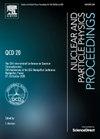为 PSI 的 muEDM 实验研发μ介子入口触发器
Q4 Physics and Astronomy
Nuclear and Particle Physics Proceedings
Pub Date : 2024-05-24
DOI:10.1016/j.nuclphysbps.2024.05.014
引用次数: 0
摘要
瑞士保罗-舍勒研究所(PSI)的μEDM实验旨在利用冷冻自旋技术在一个紧凑的存储环中探测μ介子电偶极矩(EDM),灵敏度为6×10-23 e⋅cm。快速入口探测器预计将与磁脉冲发生器协同工作,将μ介子导入所需的轨道。与此同时,入口探测器的设计还能在不引入大量多重散射的情况下否决超过仪器导纳量的μ介子。我们开发了一个入口触发探测器原型,由一个薄闪烁体(用于探测进入的μ介子)和四个壁闪烁体(作为否决探测器)组成。原型探测器在 PSI 的 πE1 光束线进行了 27.5 MeV/c 的测试。共收集到 7×105 个事件,在两种不同的光束调谐下由耦合到塑料闪烁体的 SiPM 读出。对这些事件进行了分析,以确定探测器的性能特征,并与考虑了光束相空间和闪烁过程的蒙特卡洛模拟进行了交叉检验。本文章由计算机程序翻译,如有差异,请以英文原文为准。
Research and development of a muon entrance trigger for the muEDM experiment at PSI
The muEDM experiment at the Paul Scherrer Institute (PSI) in Switzerland aims to probe the muon electric dipole moment (EDM) using the frozen-spin technique in a compact storage ring, with a sensitivity of e⋅cm. A fast entrance detector is expected to work in concert with a magnetic pulse generator to direct muons into the desired orbit. Simultaneously, the entrance detector is designed to veto muons that exceed the apparatus's admittance without introducing significant multiple scatterings. We developed a prototype entrance trigger detector consisting of a thin scintillator for detecting incoming muons and four wall scintillators as veto detectors. The prototype was tested at 27.5 MeV/c at the πE1 beamline at PSI. A total of events were collected, which were read out by SiPMs coupled to the plastic scintillators under two different beam tunes. These events were analyzed to characterize the detector's performance, which was also cross-checked with Monte Carlo simulations that took into account the beam phase space and scintillation processes.
求助全文
通过发布文献求助,成功后即可免费获取论文全文。
去求助
来源期刊

Nuclear and Particle Physics Proceedings
Physics and Astronomy-Nuclear and High Energy Physics
CiteScore
0.40
自引率
0.00%
发文量
0
期刊介绍:
Nuclear and Particle Physics Proceedings is the premier publication outlet for the proceedings of key conferences on nuclear and high-energy physics and related areas. The series covers both large international conferences and topical meetings. The newest discoveries and the latest developments, reported at carefully selected meetings, are published covering experimental as well as theoretical particle physics, nuclear and hadronic physics, cosmology, astrophysics and gravitation, field theory and statistical systems, and physical mathematics.
 求助内容:
求助内容: 应助结果提醒方式:
应助结果提醒方式:


